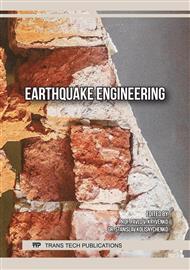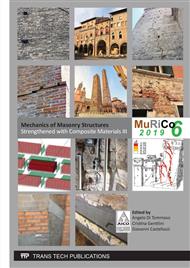[1]
Barbero E. and GangaRao H. V. S., Structural Applications of Composites in infrastructure, Part II, SAMPE Journal, Vol. 28, No. 1, (January/February 1992) , 9-16.
Google Scholar
[2]
S. L. Iyer and R. Sen Eds., Advanced Composite Materials in Civil Engineering Structures, American Society of Civil Engineers, New York, (1991).
Google Scholar
[3]
H. Saadatmanesh and M. R. Ehsani Eds., Tucson, Fiber Composites in Infrastructure, Proceedings of the First Insternational Conference on Composites in Infrastructure (ICCI'96), Arizona (January 5-7, 1996).
Google Scholar
[4]
Liao Kin, Carl R Schultheisz, and Donald L Hunston, Effects of Environmental Aging on the Properties of Pultruded GFRP (1998).
Google Scholar
[5]
Russo S., Experimental and finite element analysis of a very large pultruded FRP structure subjected to free vibration. Composite Structure (2012).
DOI: 10.1016/j.compstruct.2011.10.003
Google Scholar
[6]
Carra Guglielmo and Valter Carvelli, Ageing of Pultruded Glass Fibre Reinforced Polymer Composites Exposed to Combined Environmental Agents, Composite Structure 108 (2014).
DOI: 10.1016/j.compstruct.2013.10.042
Google Scholar
[7]
Salvatore Russo, Behzad Ghadimi, Krishna Lawania, e Michele Rosano, Residual strength testing in pultruded FRP material under a variety of temperature cycles and values, Composite Structure 133 (2015) pp.458-475.
DOI: 10.1016/j.compstruct.2015.07.034
Google Scholar
[8]
Salvatore Russo, Damage assessment of GFRP pultruded structural elements, Composite Structure 96 (2013) pp.661-669.
DOI: 10.1016/j.compstruct.2012.09.014
Google Scholar
[9]
Cecchi, S. Russo, F. Sciarretta. Preliminary investigation on FRP profiles for the structural retrofit of masonry structures. Key Engineering Materials Volume 747 (2017) pp.77-84.
DOI: 10.4028/www.scientific.net/kem.747.77
Google Scholar
[10]
Russo S., Bucklings interactions in columns made by built-up thin, open, pultruded FRP shapes. J Reinf Plast Compos 2015, 34: 972-88.
DOI: 10.1177/0731684415584953
Google Scholar
[11]
De Lorenzis, L., Nanni, A., and La Tegola, A., Bond of near surface mounted FRP rods in concrete masonry units, Proc., 7th Annual Int. Conf. on Composite Engineering (ICCE/7), Denver, 3–4 (2000).
DOI: 10.1016/s1359-8368(02)00052-5
Google Scholar
[12]
Tumialan, G., Morbin, A., Nanni, A., and Modena, C., Shear strengthening of masonry walls with FRP composites, Compos 2001 Convention and Trade Show, Composites Fabricators Association, Tampo, FL. (2001).
DOI: 10.1061/40558(2001)130
Google Scholar
[13]
EI-Dakhakhni, W. W., Hamid, A. A., and Elgaaly, M., Seismic retrofit of concrete-masonry-infilled steel frames with glass fiberreinforced polymer laminates., J. Struct Eng. (2004).
DOI: 10.1061/(asce)0733-9445(2004)130:9(1343)
Google Scholar
[14]
Silva, P. F., Yu, P., and Nanni, A., Monte Carlo simulation of shear capacity of URM walls retrofitted by polyurea reinforced GFRP grids, J. Compos. Constr. (2008).
DOI: 10.1061/(asce)1090-0268(2008)12:4(405)
Google Scholar
[15]
Mahmood, H., and Ingham, J. M., Diagonal compression testing of FRP-retrofitted unreinforced clay brick masonry wallettes, J. Compos. Const. (2011).
DOI: 10.1061/(asce)cc.1943-5614.0000209
Google Scholar
[16]
Papanicolaou G.C., Zaoutsos S.P., Viscoelastic constitutive modeling of creep and stress relaxation in polymers and polymer matrix composites. In: Guedes R.M., editor. Creep and Fatigue in Polymer Matrix Composites. 1. Cambridge: Woodhead Publishing; (2010). p.1–47.
DOI: 10.1533/9780857090430.1.3
Google Scholar
[17]
Aniskevich K., Starkova O., Jansons J., Aniskevich A. Long-Term Deformability and Aging of Polymer Matrix Composites. New York: Nova Publ. (Nova Science Publishers); (2012).
Google Scholar
[18]
Findley W.N., Lai J.S., Onaran K. Creep and Relaxation of Nonlinear Viscoelastic Materials. New York: Dover; (1989).
Google Scholar
[19]
M. H. Motta Dias, K. M. B. Jansen, J. W. Luinge H. E. N. Bersee, R. Benedictus, Effect of fiber-matrix adhesion on the creep behavior of CF/PPS composites: temperature and physical aging characterization. Mech Time Depend Mater (2016); 20(2): 245–262.
DOI: 10.1007/s11043-016-9294-z
Google Scholar



